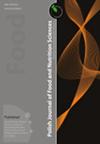Effect of the Ultraviolet C Light-Emitting Diode Treatment on the Quality of Soil-Grown and Pot-Grown Red Raspberries
IF 2.3
4区 农林科学
Q3 FOOD SCIENCE & TECHNOLOGY
引用次数: 0
Abstract
Red raspberries ( Rubus idaeus L.) are often chosen by consumers for their flavour, taste, and health-promoting properties. A relevant issue related to these fruits is their high perishability. The aim of this study was to investigate the effect of the ultraviolet C light-emitting diode (UVC-LED) treatment on soil-grown and pot-grown raspberries in extending their shelf--life, maintaining their high quality throughout the preservation period, and improving features related to their phenolic compound content. The UVC-LED treatment increased the total phenolic content (158 to 200 mg GAE/100 g) and ferric reducing antioxidant power (55.3 to 78.6 mmol Fe 2+ /kg) of the pot-grown raspberries when the UVC-LED treatment was followed by storage in a climate-controlled room (20°C). Total anthocyanin content did not increase significantly compared to the control samples. Contrary to expectations, no effect of reducing the microbial count after storage was observed due to the exposure of raspberries to the UVC-LED radiation. The positive outcomes derived from the analyses of bioactive compounds may be implemented in further studies on the same matrix to better manage the treatment and its conditions, such as the exposure time, the distance from the LED lamps, and the UVC-rays’ dose, in order to find the best combination in terms of efficacy and efficiency.紫外光C发光二极管处理对土栽和盆栽红树莓品质的影响
本文章由计算机程序翻译,如有差异,请以英文原文为准。
求助全文
约1分钟内获得全文
求助全文
来源期刊

Polish Journal of Food and Nutrition Sciences
FOOD SCIENCE & TECHNOLOGY-
CiteScore
4.30
自引率
12.50%
发文量
25
审稿时长
20 weeks
期刊介绍:
The Polish Journal of Food and Nutrition Sciences publishes original, basic and applied papers, reviews and short communications on fundamental and applied food research in the following Sections:
-Food Technology:
Innovative technology of food development including biotechnological and microbiological aspects
Effects of processing on food composition and nutritional value
-Food Chemistry:
Bioactive constituents of foods
Chemistry relating to major and minor components of food
Analytical methods
-Food Quality and Functionality:
Sensory methodologies
Functional properties of food
Food physics
Quality, storage and safety of food
-Nutritional Research Section:
Nutritional studies relating to major and minor components of food (excluding works related to questionnaire
surveys)
-“News” section:
Announcements of congresses
Miscellanea
 求助内容:
求助内容: 应助结果提醒方式:
应助结果提醒方式:


